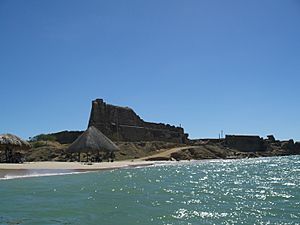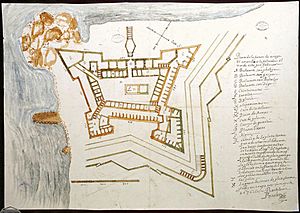Andrés Rodríguez de Villegas facts for kids
Quick facts for kids
Andrés Rodríguez de Villegas
|
|
|---|---|
| 2nd Governor of the Province of Margarita | |
| In office 6 June 1619 – 1 June 1626 |
|
| Preceded by | Francisco Gutiérrez Flores |
| Succeeded by | Garcia Álvarez de Figueroa |
| Governor of La Florida | |
| In office June 23, 1630 – July 1631 |
|
| Preceded by | Luis de Rojas y Borja |
| Succeeded by | Nicolás Ponce de León |
| Personal details | |
| Born | 1580 San Juan (Puerto Rico) |
| Died | July 1631 (died in office) Saint Augustine, Florida |
Andrés Rodríguez de Villegas (born 1580, died 1631) was a Spanish soldier and an important leader. He served as the governor and captain-general of Margarita Island in Venezuela from 1619 to 1626. Later, he became the governor of Spanish Florida from 1630 until his death in 1631.
Contents
Biography
His Early Life
Andrés Rodríguez de Villegas was born in 1580 in San Juan, Puerto Rico. His father, Antonio Rodríguez de Villegas, was a hidalgo, which meant he came from a noble family in Spain. His father was also a judge (called an oidor) and had an advanced university degree.
In 1604, Andrés joined the Spanish Army as an infantry soldier and served for 15 years. After that, he joined the royal Spanish Navy. He sailed to far-off places like the Moluccas and the Philippines. He became a Captain of a ship and later rose to the rank of "Admiral" in the Pacific Ocean.
His older brother, Antonio Rodríguez de Villegas, was given a special job in 1607. He was asked by the Viceroy of New Spain to find out why the captain general of the Philippines had died.
His Political Career
Governor of Margarita Island
Andrés Rodríguez de Villegas was chosen to be the governor of Isla de Margarita, Venezuela. He arrived on June 6, 1619, and officially started his job on August 1. He immediately wrote to King Philip III to tell him that the defenses of Araya were weak. He explained that they urgently needed to be improved because Dutch ships were taking large amounts of salt from nearby salt fields.
The Dutch attacked the Araya Peninsula twice in 1620, but the Spanish forces fought them off. This had also happened before in November 1605. On January 15, 1622, several Dutch boats came to Araya to load salt. Then, a fleet of 27 Dutch ships arrived and started building two forts and saltworks. This happened at the same time that Spain's government in Madrid decided to build forts to protect the salt fields.
On February 22, Villegas decided to leave Pampatar right away. He brought 20 soldiers and 12 Waikerí archers to fight the Dutch troops at Santiago. However, his soldiers refused to join him when he launched his attack. When he saw the main Dutch group landing to the east, he stopped his attempt. But his troops were able to stop the Dutch from landing at the harbor of Pueblo de la Mar, and several Dutch soldiers were killed. By a royal order on March 13, 1622, the building of the fortress at Araya was to begin.
On November 30, 1622, a fleet of 43 Dutch ships attacked Araya. Their goal was to stop the Spanish from building their fortress and to take over the peninsula. After two months of fighting, the Spanish forces drove out the invading fleet on January 13, 1623.
On April 24, 1623, Villegas met with the governor of New Andalusia, Diego de Arroyo. He also met with military engineers Juan Bautista Antonelli and Cristobal Roda Antonelli. They discussed the plans for the new fortress. Governor Rodríguez presented his own plan to the King of Spain. However, the plan submitted by Roda was chosen. On May 15, Rodríguez sent a letter with the chosen plan for the project. By January 1625, he had built the first part of the Real Fortaleza de Santiago de Arroyo de Araya (Royal Fortress of Santiago of Arroyo of Araya). But on February 6, he wrote to the king that the structure had fallen down. This happened because its foundations were too close to the beach, and ocean waves had washed them away.
Villegas handed over command of Margarita Island to Garcia Álvarez de Figueroa on June 1, 1625. The Royal Court said that he was a fair governor and very dedicated to his administrative duties.
Governor of La Florida
On June 23, 1630, Andrés Rodríguez de Villegas was appointed governor of La Florida. He held this position until September 21, 1631, when he died while still in office. He was replaced by two temporary governors, Nicolas Ponce de Leon and Sergeant Major Eugenio Espinosa. They governed until Luis de Horruytiner took over on July 29, 1633.
Andrés Rodríguez de Villegas died as governor of La Florida on September 29, 1631. He passed away in St. Augustine, which was the capital of Spanish Florida. The cause of his death is not known.
See also
 In Spanish: Andrés Rodríguez de Villegas para niños
In Spanish: Andrés Rodríguez de Villegas para niños



